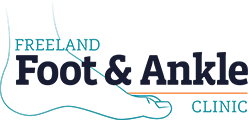As fall sports kick into high gear, it's common to see athletes — especially football, soccer, and cross-country runners — wrapping their ankles or feet in layers of tape before hitting the field. It’s a familiar ritual that looks serious and preventative, but is taping always the best option?
At Freeland Foot & Ankle Clinic, we specialize in  non-surgical treatments for all ages — from active kids to seasoned athletes — and we're breaking down the truth behind athletic taping: when it helps, when it doesn’t, and what safer long-term alternatives exist.
non-surgical treatments for all ages — from active kids to seasoned athletes — and we're breaking down the truth behind athletic taping: when it helps, when it doesn’t, and what safer long-term alternatives exist.
Why Do Athletes Tape Their Ankles or Feet?
Athletic taping is often used to:
-
Prevent ankle sprains or rolls
-
Support a previously injured foot or ankle
-
Provide a feeling of extra stability during high-impact activity
-
Reduce swelling or control movement post-injury
In fast-paced fall sports like football, soccer, and cross country, where athletes are constantly cutting, jumping, and pivoting, that extra support can feel essential. But there’s a fine line between helpful support and a false sense of security.
The Pros and Cons of Taping
When Taping is a "Treat":
-
Short-term support for weak or recovering joints
-
Quick solution during practice or game time
-
Provides compression to control swelling (when done properly)
When Taping Can Be a "Trick":
-
Overuse can lead to muscle weakness or dependency
-
Incorrect technique can restrict circulation or worsen an injury
-
Taping alone does not prevent injuries — it just masks symptoms
-
Can limit natural range of motion over time
Many athletes rely too heavily on tape without addressing the underlying cause of instability — which can lead to repeat injuries or even long-term damage.
Common Taping Mistakes We See
At Freeland Foot & Ankle Clinic, we frequently treat patients who have been:
-
Taping too tightly, leading to numbness or bruising
-
Using improper tape (e.g., KT tape when athletic tape is needed — and vice versa)
-
Self-taping without guidance — especially young athletes watching YouTube tutorials
-
Failing to combine taping with rehab, bracing, or professional evaluation
Tape Smart: Our Expert Recommendations
Here’s what Dr. Dailey and our team recommend for fall athletes considering taping:
-
Use taping as a short-term aid, not a permanent solution
-
Seek professional guidance — improper taping can do more harm than good
-
Pair taping with physical therapy or strengthening routines
-
Don't ignore pain — taping shouldn’t replace medical evaluation
-
Consider bracing or orthotics for safer, longer-term support
Better Than Tape? Try a Personalized Approach
We offer:
-
Gait analysis to assess movement and foot alignment
-
Custom orthotics tailored to athletes’ needs
-
Non-surgical treatment plans to build strength and stability
-
Sports injury evaluations for youth and adult athletes alike
Taping may be a temporary fix, but real injury prevention starts with proper care — and that's exactly what we provide at Freeland Foot & Ankle Clinic. Call us today at 989-695-6788 to schedule an appointment.
